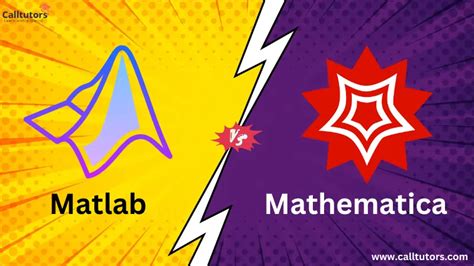Introduction

MATLAB and Mathematica are two of the most widely used mathematical software programs available today. They both offer powerful features and capabilities, making them a good option for a variety of engineering, computing, and scientific fields.
MATLAB: The Workhorse of Numerical Computing
MATLAB is a high-performance language developed by MathWorks that is specifically designed for numerical computing. It is widely used for tasks such as:
- Data analysis and visualization
- Signal processing
- Image processing
- Machine learning
- Computational finance
MATLAB is known for its strong data manipulation capabilities, built-in functions, and extensive libraries of toolboxes that provide specialized functionality for specific domains. It also offers a user-friendly graphical interface, making it accessible to users with varying levels of programming experience.
Market Share and Popularity
According to a 2020 survey by IEEE Xplore, MATLAB holds a market share of 53.2% in the numerical computing software market, followed by Mathematica at 29.4%. This indicates MATLAB’s dominance in the industry, particularly in academia and research institutions.
Mathematica: The Swiss Army Knife of Symbolic Computing
Mathematica is a versatile software package developed by Wolfram Research that combines symbolic computation, numerical evaluation, and graphical visualization. It is particularly strong in areas such as:
- Symbolic mathematics
- Differential equations
- Optimization
- Geometry
- Physics
Mathematica is known for its powerful symbolic computation engine, which allows users to perform complex mathematical operations on symbolic expressions. It also provides a wide range of built-in functions for a variety of mathematical domains, as well as a comprehensive collection of documentation and tutorials.
Applications and Use Cases
MATLAB and Mathematica have overlapping capabilities but are often used in different contexts.
MATLAB is commonly used for:
- Engineering simulations
- Data analysis
- Machine learning
- Image processing
Mathematica is commonly used for:
- Theoretical physics
- Differential equations
- Symbolic mathematics
- Computer algebra
Comparison of Key Features
| Feature | MATLAB | Mathematica |
|---|---|---|
| Numerical computation | Strong | Good |
| Symbolic computation | Limited | Strong |
| Data visualization | Good | Excellent |
| Built-in functions | Extensive | Comprehensive |
| Toolboxes | Customizable | Predefined |
| User interface | Graphical | Notebook-style |
Pricing and Licensing
MATLAB and Mathematica are both commercial software programs with varying pricing models. MATLAB offers perpetual licenses, while Mathematica offers both perpetual and subscription-based licenses.
The cost of MATLAB depends on the specific toolboxes and features included in the license. Mathematica’s pricing is based on the number of users and the type of license (perpetual or subscription).
Choosing the Right Tool
The choice between MATLAB and Mathematica depends on the specific requirements of your project or application.
Consider MATLAB if:
- You primarily need numerical computing capabilities.
- You need customizable toolboxes for specific domains.
- You prefer a user-friendly graphical interface.
Consider Mathematica if:
- You need strong symbolic computation capabilities.
- You need comprehensive documentation and tutorials.
- You prefer a notebook-style user interface that combines code and documentation.
Conclusion
MATLAB and Mathematica are both powerful mathematical software programs with their own strengths and weaknesses. MATLAB excels in numerical computing, data visualization, and machine learning, while Mathematica stands out in symbolic computation, differential equations, and theoretical physics. By understanding the key differences between these two software programs, you can make an informed decision about which one is right for your needs.
